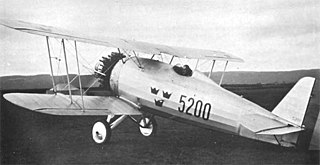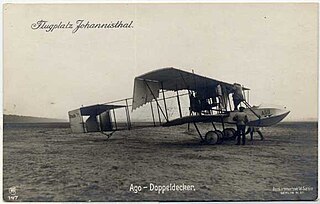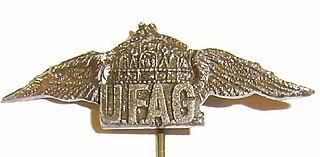
Messerschmitt AG was a German share-ownership limited, aircraft manufacturing corporation named after its chief designer Willy Messerschmitt from mid-July 1938 onwards, and known primarily for its World War II fighter aircraft, in particular the Bf 109 and Me 262. The company survived in the post-war era, undergoing a number of mergers and changing its name from Messerschmitt to Messerschmitt-Bölkow-Blohm before being bought by Deutsche Aerospace in 1989.

Hugo Junkers was a German aircraft engineer and aircraft designer who pioneered the design of all-metal airplanes and flying wings. His company, Junkers Flugzeug- und Motorenwerke AG, was one of the mainstays of the German aircraft industry in the years between World War I and World War II. His multi-engined, all-metal passenger- and freight planes helped establish airlines in Germany and around the world.

Dr. Ernst Heinkel was a German aircraft designer, manufacturer, Wehrwirtschaftsführer in the Nazi Germany, and member of the Nazi party. His company Heinkel Flugzeugwerke produced the Heinkel He 178, the world's first turbojet aircraft and jet plane, and the Heinkel He 176, the first rocket aircraft.
Camillo Castiglioni was an Italian-Austrian Jewish financier and banker, and was the wealthiest man in Central Europe during World War I. Nicknamed "Austrian Stinnes", he was active in aviation's pioneering days and invested in the arts. Castiglioni was credited as being instrumental to the founding of what would eventually become BMW AG.

The Albatros B.II, was an unarmed German two-seat reconnaissance biplane of the First World War.

Ignaz "Igo" Etrich, Austrian flight pioneer, pilot and fixed-wing aircraft developer.

The Austro-Hungarian Aviation Troops or Imperial and Royal Aviation Troops were the air force of the Austro-Hungarian Empire until the empire's demise in 1918; it saw combat on both the Eastern Front and Italian Front during World War I.

Svenska Aero AB (SAAB) was a Swedish aircraft manufacturer on Hästholmen in Lidingö. The company was founded September 10, 1921, to license build Caspar-Werke and Heinkel aircraft. The company was bought by ASJA in 1932.

The Rumpler 6B was a German single-engine floatplane fighter with a biplane wing structure, designed and built by Rumpler Flugzeugwerke, in Berlin Johannisthal and introduced in 1916.

AGO Flugzeugwerke was a German aircraft manufacturing company from 1911 until 1945. The initials AGO had a variety of meanings during the company's lifetime, but in its final version stood for Apparatebau GmbH Oschersleben. At its peak, the company employed around 4,500 people.

The Hansa-Brandenburg W.12 was a German biplane fighter floatplane of World War I. It was a development of Ernst Heinkel's previous KDW, adding a rear cockpit for an observer/gunner, and had an unusual inverted tailfin/rudder in order to give an uninterrupted field of fire.

The Hansa-Brandenburg W.29 was a German monoplane fighter floatplane which served in the closing months of World War I, from bases on the North Sea coast.

The Hansa-Brandenburg C.I, also known as Type LDD, was a 2-seater armed single-engine reconnaissance biplane designed by Ernst Heinkel, who worked at that time for the parent company in Germany. The C.I had similarities with the earlier B.I, including inward-sloping interplane bracing struts. Like other early-war Austro-Hungarian reconnaissance aircraft, such as C-types of Lloyd or Lohner, the Type LDD had a communal cockpit for its crew.

Hansa-Brandenburg W.33 was a German two-seat, single-engined low-wing monoplane floatplane, which had been developed by Hansa und Brandenburgische Flugzeugwerke during World War I as a higher powered enlargement of the similar Hansa-Brandenburg W.29 and despite the increase in size the two types are very difficult to differentiate. Although the W.33 was built in small numbers during the war many license built versions were built after World War I.

The Hansa-Brandenburg W.19 was a German fighter-reconnaissance aircraft of World War I. It was a single-engined two-seat biplane floatplane, and was a larger development of the successful W.12. It served with the Kaiserliche Marine during 1918.

The Hansa-Brandenburg W.13 was a flying boat bomber developed in Germany in 1917 and used by the Austro-Hungarian Navy during World War I.
Etrich Flugzeugwerke (EFW) was a short-lived aircraft manufacturer founded by Igo Etrich.

UFAG, was a Hungarian aircraft manufacturer formed by the Ganz Works and the Manfred Weiss Works in Budapest two years before the World War I. They built aircraft of their own design as well as under licence from Lohner and Hansa-Brandenburg.
The German Air Ministry had a system for aircraft designation which was an attempt by the aviation authorities of the Third Reich to standardize and produce an identifier for each aircraft design's airframe type produced in Germany. It was in use from 1933 to 1945 though many pre-1933 aircraft were included and the system had changes over those years. As well as aircraft of the Luftwaffe, it covered civilian airliners and sport planes, due to the RLM handing all aviation-related matters in the Third Reich, both civilian and military in nature.
Hansa-Brandenburg W.34 was a prototype German two-seat, low-wing single-engined seaplane, which had been designed by Hansa und Brandenburgische Flugzeugwerke during World War I.















